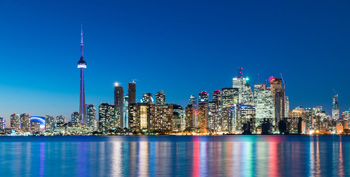Practical back alley or cottage dock? Waterfront debate splits Toronto
7/6/2015
| SHARE
Posted in Toronto News by Vanguard Realty | Back to Main Blog Page

In 1852, civil engineer John G. Howard drew a colour map of his plan for the Toronto waterfront. The sketch showed a park stretching from Bathurst to York Sts., awash in green and webbed with footpaths. In his very Victorian way, Howard imagined “Pleasure Drives, Walks and Shrubbery for the Recreation of the Citizens.”
Unveiled last Friday, the renovated Queens Quay recaptures some of Howard’s concept. If it isn’t quite a consummation of his dream waterfront — less shrubbery, for one thing — it’s certainly an approximation of it.
Planners and designers have high hopes that the thoroughfare, billed as a “complete street” and paved with more than 2 million small pieces of Canadian granite, will enliven the once-moribund stretch of lakefront and turn it into a true “destination.”
That it took more than 150 years to build a central waterfront “for the recreation of the citizens” is testament to the ambiguity of purpose that has dogged the shoreline for generations. Long pulled between competing jurisdictions and priorities — now a patch of wharves and factories, now a route for city highways, now a federally run tourist draw — the area bordering the lake has struggled to find an identity.
Those tensions have been given new life this summer, amid the fight over the eastern Gardiner, the Queens Quay reopening, and last week’s vote by city council’s executive committee to continue supporting Waterfront Toronto — but commission a value-for-money audit.
At stake is the future of the lakefront, which advocates say is crucial to staying competitive in the 21st century, particularly in attracting skilled workers. Broadly speaking, should the lakeshore be more like a back alley or a cottage dock? Cheap and functional, and mostly used for transportation? Or leafy and leisurely — a place to hang out on a summer’s day?
Toronto has long been torn on that question. Over the centuries, residents have treated the waterfront as everything from a portage route to an armory. As McMaster University historian Jennifer Bonnell notes, the mouth of the Don River was a place to store gunpowder in the 1790s.
Through much of the 19th century, the lake was dominated by industry. Effluent from factories along the Don turned Ashbridge’s Marsh into an open sewer: festering, slimy and disease-ridden. Using the lakeshore as a place to store hazardous waste didn’t make the area any more inviting to weekenders.
And of course, Toronto’s section of Lake Ontario was a working port, with all the attendant noise and pollution, well into the 20th century; its gradual decline only began in the late 1960s.
“We have this 150-year history of not turning towards the waterfront but turning away from it,” Bonnell said.
But the city has also gone through fleeting moments of embracing the lake as a place to enjoy. Sunnyside Beach, dubbed “the poor man’s Riviera,” featured a Bathing Pavilion that opened in 1922, and an adjacent amusement park that featured such dubious entertainments as pole-sitting contests and bears riding bicycles.
But the populist park had larger ambitions: “Sunnyside Beach heralds the greatness of this Canadian metropolis,” exclaimed a promotional magazine published in the early 1920s. Being there on a late Saturday afternoon could make you feel like “you were somehow at the source of things,” wrote the humorist Robert Thomas Allen, in his foreword to the nostalgic tome I Remember Sunnyside — “a warm and tattered tent of life.”
By the 1950s, the city’s glut of cars reached critical mass; the amusement park was torn down in 1955 to make way for what would become the Gardiner Expressway. “Nothing can be permitted to hold up progress,” read a Star editorial on the demolition.
Only in the past 15 years or so did the city’s political class reach something like a consensus that the waterfront should be an attraction — a place, rather than a corridor, as Bonnell puts it.
The Toronto Waterfront Revitalization Corporation, later renamed Waterfront Toronto, was created in 2001 with $500 million of funding from each of the three levels of government. John Campbell, the group’s CEO, said in an interview that historic neglect of the lakeshore stemmed in part from the construction of highways along the southern extent of the city.
“That came from the kind of post-Second World War auto culture,” he said. “Our whole society was designed around the car.”
In 2015, Campbell says, the waterfront should act as a kind of brochure for the city and draw skilled immigrants to Toronto.
“These are tactics,” he said, in reference to Waterfront Toronto’s revitalization efforts. “What we’re trying to do is attract talent.”
Waterfront Toronto chair Mark Wilson echoed that thought at the Queens Quay ribbon-cutting. “The waterfront is a front door. It’s our face to the world,” he said. “Think of all the pictures, the postcards. What do they shoot? They shoot back to the waterfront. The waterfront is actually quite central to our image worldwide. It’s our global calling card.”
Not everyone sees it this way. Stephen Holyday, the city councillor for Etobicoke Centre, is among the chorus of skeptics who are in no rush to see the lakeshore move away from its historic purpose of transporting people through downtown.
Like many of that mind, Holyday voted earlier this month to maintain the Gardiner East in “hybrid” form — essentially intact — rather than tearing the elevated portion east of Jarvis St. down to be replaced by an at-grade boulevard.
He’s a fan of the lake, he says, with memories of riding along the shore in Etobicoke as a kid. But the big barrier to the water, Holyday believes, is not the Gardiner — an argument often made by expressway opponents — but the rail corridor immediately to the Gardiner’s north, which forces pedestrians to walk through dank tunnels to reach the waterfront.
He also made a point rarely voiced in debates about the wisdom of investing in a more pleasant shoreline: Toronto is a winter city for which, unlike Sydney or San Francisco, the waterfront is really a destination for only about half the year.
“I would use that context in the decisions that we make,” Holyday said. “Do you go and buy a cottage because you go and use it one week a year, or do you rent it because that’s a better use of the money?”
Many of those who agree with Holyday are fellow suburbanites. A much remarked-on map of the Gardiner vote showed the city largely split between the old city of Toronto and Etobicoke, North York and Scarborough on the issue.
Deputy Mayor Denzil Minnan-Wong is certainly the most vocal conduit for suburban resentment of waterfront revitalization. A persistent thorn in the side of Waterfront Toronto, he now represents the City of Toronto on its board. He is known for needling the organization over the cost of decorative additions at Sugar Beach — large permanent umbrellas and granite boulders — but Minnan-Wong thinks the extravagance is more widespread than that. He advocates for an economical, bare-bones shoreline.
“You go to Sunnyside boardwalk on the weekend and it’s packed, you can’t find a place to put down your blanket,” he said in a recent interview. “You don’t need fancy-pants pink umbrellas for that. People don’t say, ‘I’m not going to Sunnyside beach because it hasn’t won any design awards.’”
While Minnan-Wong says he finds the new Queens Quay pleasant enough, he sees in the project’s excesses — it came in $36 million over budget — a stark bias among city planners for downtown infrastructure, and a heedlessness with public money that tips into arrogance.
“There is an issue when the streets of the waterfront are paved with gold, yet in other parts of the city, you can’t get repairs to an ice rink,” he said.
Many proponents of a more pedestrian-friendly shoreline say that if city residents feel alienated from the lake, it’s not because of cost overruns or expensive building materials, but because of the Gardiner. It acts as a physical and psychological barrier to the waterfront, they argue — and failing to tear down its eastern appendage was a historic mistake.
“Some people may have already abandoned hope of a recreational waterfront,” said Kristyn Wong-Tam, councillor for Toronto Centre-Rosedale.
Maintaining the eastern Gardiner is like “going into a time capsule,” she added.
“This parochial backwards-thinking, where we’re still building a city where the car is king — that has to be abandoned.”
An east-ender whose life is closely connected with the shore, Ward 30 Councillor Paula Fletcher fears that the city too often forgets the benefits of its lake.
“Life in the east is very focused along the waterfront,” she said. “People are out at the Leslie Spit. They’re out at the Woodbine beach all weekend … It’s part of your psyche.”
“People love to be close to the water,” said the left-leaning councillor. “I don’t what it is about the human psyche, but there’s something very special about water.”
It’s that sense of perspective that Fletcher feels has been missing from the waterfront debate.
“Hey people,” she said, “we live on a lake!”
GTA News, Real Estate Market, Real Estate News, Real Estate Trends, Toronto Entertainment, Toronto Housing, Toronto Real Estate, Toronto Residential

Thinking of buying or selling a property, or have a question regarding the real estate market? Fill out the form below and we'll get back to you promptly.
